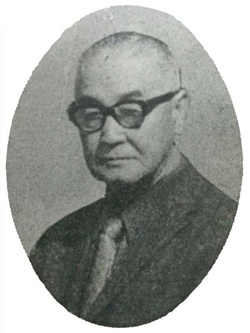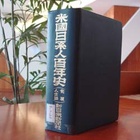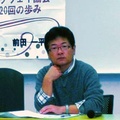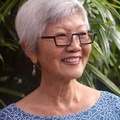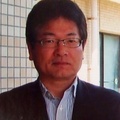第2回 「加藤新一の仕事(上)」を読む >>
新日米新聞社の編集主幹として「米國日系人百年史」を取材、執筆、編集した加藤新一は、太平洋戦争を挟んで日米を行き来して生涯を終えた。アメリカに対する思いは被爆体験からすれば複雑だったはずだが、アメリカの民主主義を評価し移住した日本人・日系人の足跡を記録、後半生は平和運動に尽力した。
加藤は1900(明治33)年9月広島市に生まれる。1916(大正5)年、修道中学1年のとき、すでにカリフォルニアのフレスノでブドウ栽培をしていた父親に呼び寄せられ、現地のハイスクールに通った。23年に父親は帰国するが加藤はロサンゼルス郊外のパサデナに落ち着いた。
1925年に羅府新報に入社、その後加州毎日で3年記者として働いたのち、アメリカ資本に押される在米同胞のために産業組合運動を推進、「米国産業日報」という機関紙を創刊し副社長兼編集長となった。また、南加州農産連盟支配人をつとめた。
しかし太平洋戦争がはじまると社の幹部であった彼は、1941年2月から42年6月までモンタナ州のミヅラ収容所に抑留される。ここは司法省管轄の収容所の一つでアメリカ政府にとって問題ありとみなされた「アメリカ市民以外の人間たち」が収容された。
1942年8月には第1回の(戦時)交換船で帰国し、翌年9月に郷里の広島にある中国新聞社に入社、広島に原爆が落とされたときは報道部長だった。8月6日午前8時15分の原爆投下の直前、加藤は出勤途中で宮島線己斐駅(西広島駅)で、市内電車への乗り換えのため行列の末尾で朝刊を読んでいた。
一瞬の青白い大閃光と大轟音にたたきつけられた彼は、すぐさま市内の中国新聞社へ向かい、その後自宅の平良村(廿日市市)へ戻る。この間市内で見聞きした凄惨な光景はのちに「原爆生き地獄を往く~一老記者のピカドン体験記」として著している。
* * *
「兵隊さん、水を」という断末魔の声を耳にしながら、どうすることもできず心で詫びて突っ走る。「黒焦げの死体や半死半生の被爆者やタイヤの燃えた自転車を飛び越えて進む…」、「逃げ遅れた男女中学生たちが、熱さにたまらず、水をもとめて水槽に折り重なって赤くユデダコのように死に、なかには握りコブシを高くあげ、苦しみつつ絶息…」
また、墜落した米機から逃れた米兵が民衆にとらえられたのだろう。
「…電柱に赤くただれた大男が針金でくくられ、往来する人々が何か言いながら煉瓦や小石を投げている」。
自宅にいた妻子は無事だったが、3日後に弟が死亡した。終戦後は、アメリカ原爆視察団に同行したスイスの万国赤十字代表2人の案内や通訳に駆り出され、凄惨な現場を何度も歩き回った。そして1ヵ月後には妹が、「兄さん仇を討って」と言い残し亡くなった。
終戦後は編集局次長、文化局次長などを歴任するが、同社で従業員組合が結成されると初代の組合長に就任し活躍。1949(昭和24)年4月からは当時の楠瀬常猪知事に請われて初代の広島県広報委員会委員長をつとめるかたわら日本国際連合協会広島県本部の事務局長となる。
東西の冷戦がはじまり、核戦争の危機が現実味をもって危惧されるようになったころで、自らの被爆体験もあり世界平和を希求する加藤は、こうした対立を避けるため世界政府をつくろうという世界連邦設立の運動に関わる。1952年11月に世界連邦建設同盟のアジア会議が広島で開かれた際は事務局長をつとめた。
翌1953年4月には再び渡米、日米間の文化・経済交流事業に関わり、その後ロサンゼルスの新日米新聞社の編集主幹となってから「米國日系人百年史」を手がけることになる。そして、同社が幕を閉じた1967年に再び日本に戻り、世界連邦広島県協議会理事長をつとめ、海外にも足を運び世界連邦主義を説き、第3代国際連合事務総長ウ・タントが提唱した「地球市民運動」では、地球市民広島連合代表となった。
「一国で平和を保たれる国なんかありゃーしない。キミ、二十一世紀の平和哲学は“相互依存”。人類は同じ家族なんだ。・・・」、「国連に人民会議を作らせる。国家をなくし世界を一つの連邦に。軍事費を太陽エネルギーの開発と食糧増産へ向けるんだ。…」(1978年5月26日付中国新聞)と、加藤は生前訴えている。
1978年、第1回国連軍縮特別総会にあわせて、ニューヨークで市民団体が開いた「生存のための大動員集会」には、原爆で亡くなった弟と妹の遺影を胸に参加した。かつてのアメリカへの復讐心は平和運動へのエネルギーに転嫁していた。
平和運動の一方で、自らアメリカ移住経験者でもある彼は、在米の広島県人とのパイプ役となる「広島北米クラブ」の発起人にも名を連ね、移民先から帰郷する際の便宜を図ることにも尽力した。
1982年2月9日、広島市の自宅で脳梗塞のため81歳で生涯を終えた。ジャーナリストとして平和運動家として、行動し理想を求めた熱血の生涯だった。(敬称略)
参考:
「平和競存の創造」(1971年、加藤新一著、地球人友の会発行)
「ながれ」(1954年、村上哲夫著、村上十目子発行)
「1978年5月26日付中国新聞広島版」
「1982年2月10日中国新聞・加藤新一氏訃報)
※編集部より:読者のみなさんのなかで加藤新一氏のご家族などについてご存知の方がいらしたら、ディスカバーニッケイまでご連絡願います。今後の取材の参考にさせていただきます。連絡先: Editor@DiscoverNikkei.org
© 2014 Ryusuke Kawai


